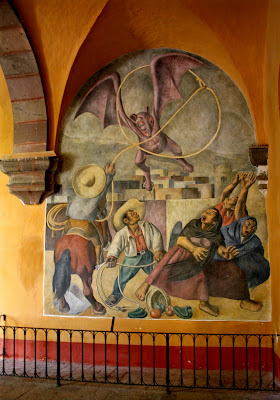 Mayer Shacter and his wife, Susan Page, found this property in 2001 which consisted of two warehouses that had been a factory for rattan furniture.
Mayer Shacter and his wife, Susan Page, found this property in 2001 which consisted of two warehouses that had been a factory for rattan furniture. They transformed the property and buildings into a striking home (above) and gallery (below). It has been referred to as "contemporary organic" and even "modern baroque."
Located five miles outside of San Miguel de Allende, their gallery and home sits on eight acres among beautiful, old mesquite trees and lush landscaping.
Yesterday morning, my group and I traveled to the countryside to tour two homes. Both have outstanding art collections and Shacter's property is one of my all time favorite stops.
 The gallery houses one of the best folk art collections around. Their home also displays their amazing, personal folk art along with a few other pieces for purchase.
The gallery houses one of the best folk art collections around. Their home also displays their amazing, personal folk art along with a few other pieces for purchase. Mayer has one of the finest private collections of old serapes from the "post-classic" period dating from 1875 to 1940. They are available to view (and purchase) upon request.
Mayer has one of the finest private collections of old serapes from the "post-classic" period dating from 1875 to 1940. They are available to view (and purchase) upon request.Their collection consists of folk art from all over Mexico; ceramic figures by the Aguilar family from the Oaxaca area, burnished ceramic pots and plates from Tonala (an area outside of Guadalajara), antique furniture, inlaid wood boxes, lacquer trays, paper mache figures, retablos, santos, huichol, old jewelry and much more.
 This is the tranquil setting of the pool, with an old limb of a Mesquite tree growing over the water.
This is the tranquil setting of the pool, with an old limb of a Mesquite tree growing over the water.
Besides having the amazing selection of folk art, it's just a beautiful place to visit.
If you do not want to carry your purchases home with you, Mayer will be more than happy to arrange to have your newly acquired treasures shipped back to you in the states.

 Here's Jennifer, from my January tour group, singing and dancing with the mariachis to "Cielito Lindo." It was a song that she had sung in her high school days when she was in the school's Fandango program.
Here's Jennifer, from my January tour group, singing and dancing with the mariachis to "Cielito Lindo." It was a song that she had sung in her high school days when she was in the school's Fandango program. Caminos de Guanajuato - Click on the the left to hear "The streets of Guanajuato," one of my favorite songs! I had a great time shooting these videos.
Caminos de Guanajuato - Click on the the left to hear "The streets of Guanajuato," one of my favorite songs! I had a great time shooting these videos. Perdido Click on Perdido to the left. "El Nino Perdido" is one of the most beautiful songs with the dueling trumpets looking for the lost child. Notice how the trumpeters finally come together. Join me in the jardin for a little mariachi music!
Perdido Click on Perdido to the left. "El Nino Perdido" is one of the most beautiful songs with the dueling trumpets looking for the lost child. Notice how the trumpeters finally come together. Join me in the jardin for a little mariachi music! 


















































